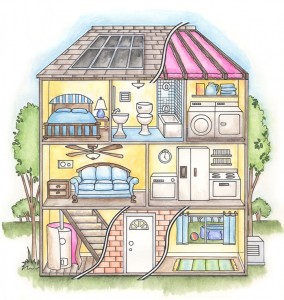 As I drive my children to their after-school activities, I’ve noticed more and more for sale signs along the roads around our house – a sure sign of spring! As we approach house-hunting and moving season, it’s a good idea to look at the evidence on house-hunting.
As I drive my children to their after-school activities, I’ve noticed more and more for sale signs along the roads around our house – a sure sign of spring! As we approach house-hunting and moving season, it’s a good idea to look at the evidence on house-hunting.
Of course, choosing a place to live is a subjective activity. Some people value more space, while other are looking for high-end finishes. Some people want to live in the suburbs of country with a lot of land, while others prefer to live in towns and cities.
But there are some elements of house hunting where the evidence comes into play. It’s these items you don’t necessarily think about when you walk into a house for the first time, but they are important basics that can cost a lot of money, or can make living in a new home a miserable experience.
To uncover what house hunters need to know, I turned to my local Cooperative Extension office. They have a whole topic area dedicated to home, including some useful information about buying a home. Their research-based fact sheets on mold, lead, and radon to help house-hunters keep an eye out for potentially hazardous conditions. Thanks to the information they provided, here are a few specific actions you can take in your search for a new home:
- If you find a house that is built before 1978, the data shows that it is important to test for lead-based paint.
- No matter what house you find, have a radon test to make sure that it doesn’t have high levels of this dangerous gas. (My county is considered a high radon-risk zone and our house tested positive. Before we moved in, we asked our previous owners to install a system that would clear radon from the air in our basement.)
- Check for moisture in closets and basements because that is sign for mold in potential new homes.
In addition to these safety aspects, the Internet now provides financial histories of houses with only a few mouse clicks. Most county assessor’s offices offer background such as previous sale prices, tax bills and a list of renovations made. While this has always been public information, it’s now much easier to access. In addition, web sites like http://zillow.com and http://trulia.com compile assessor’s data to provide neighborhood averages and comparisons.
When making a large purchase like a home, it’s wonderful to have all of this data – literally at your fingertips.



You also need to check if the house is big enough for your needs. Sellers might put smaller furniture to make it seem bigger. Make sure you’re not fooled by the staging area to make the home more appealing. Also check how old the roof is because replacing the roof can be expensive.